|
|
EDITORIAL: Multidimensional Advances in Dielectric Materials
WU Di, LEI Wen, MA Mingsheng
2025 Vol. 40 (6): 561–562
 Abstract
Abstract(
380 )
 HTML
HTML(
44)
 PDF
PDF(237KB)(
1326
)
As a vital category of functional materials, dielectric materials underpin advancements ranging from the high-speed transmission in 5G/6G communications to the precise sensing capabilities of intelligent sensors, all enabled by their unique dielectric, piezoelectric, and ferroelectric properties. As material design advances from macroscopic scale to atomic-level precision, and performance optimization shifts from empirical accumulation to data-driven intelligence, research on dielectric materials has entered a new phase characterized by transformative innovation. By controlling crystal defects, domain structures, and interfacial characteristics, dielectric materials exhibit smarter responsive behaviors. For instance, texturing techniques have improved lead-based piezoelectric ceramics; new ferroelectric states have emerged in Ruddlesden-Popper structures; and microwave dielectric ceramics have achieved greater temperature stability without sacrificing permittivity. These advances demonstrate the significance of atomic-level design and multidimensional control in advancing dielectric materials. This special issue compiles cutting-edge research in the field. Prof. Wang Ke and Prof. Li Fei analyzed progress on lead-based textured piezoelectric ceramics. Prof. Liu Xiaoqiang explored unconventional ferroelectric mechanisms in Ruddlesden-Popper structures. Prof. Li Enzhu proposed molecular-level design guidelines for microwave dielectric ceramics based on P-V-L bond theory. Prof. Zhou Di reassessed Ba(Nd1/2Nb1/2)O3 ceramics, and Prof. Li Lingxia advanced terahertz dielectric research with MgNb2O6 ceramics. Notable breakthroughs include Prof. Fang Liang’s discovery of a Rattling-effect mechanism to enhance thermal stability in microwave ceramics, and Prof. Lei Wen and Prof. Zhang Bo's researches on performance enhancement in microwave ceramics via ion doping. Additionally, Prof. Zhu Jianguo and Prof. Zhou Zhiyong independently developed self-doping strategies for lead-free piezoelectric materials, while Prof. Wang Yaojin demonstrated the “structure determines properties” paradigm by optimizing PZT-based ceramics through phase boundary and domain engineering. In fabrication and characterization, Prof. Zheng Mupeng’s team pioneered low-temperature sintering techniques, and Prof. Ma Mingsheng and Prof. Liu Zhifu designed composite oxide sintering aids to reduce sintering temperatures. Prof. Wen Zheng and Prof. Xu Fangfang utilized PFM and EELS to analyze ultrathin film relaxation and MLCC elemental structures, laying the groundwork for miniaturized dielectric devices. These efforts bridge academia and industry, driving sustainable high-performance materials. Looking forward, three trajectories will guide future developments: (1) theoretical evolution, with the shift from empirical models to multiscale simulations integrated with machine learning for smart material design; (2) multifunctional integration, aiming to engineer materials with coupled opto-electro-mechanical- thermal responses for adaptive systems; (3) atomic-scale fabrication, leveraging epitaxial growth and topological assembly to create artificial materials with atomic precision. These trends position dielectric materials as crucial enablers in quantum computing, terahertz communications, humanoid robots, and other strategic fields. We extend the deepest respect to researchers advancing dielectric materials. Through interdisciplinary collaboration and industry-academia partnerships, this field will continue delivering transformative innovations for both technological and societal progress.

|
|
|
Research Progress on Lead-based Textured Piezoelectric Ceramics
WU Qiong, SHEN Binglin, ZHANG Maohua, YAO Fangzhou, XING Zhipeng, WANG Ke
2025 Vol. 40 (6): 563–574
 Abstract
Abstract(
458 )
 HTML
HTML(
49)
 PDF
PDF(2187KB)(
1622
)
Lead-based textured piezoelectric ceramics have significantly lower production costs compared to single crystals with performance that notably exceeds that of non-textured ones. They are regarded as the most promising alternative to lead zirconate titanate polycrystalline ceramics and have emerged as a key research topic in the materials science field in recent years. This paper provides a comprehensive overview of the growth principles and characterization methods for lead-based textured piezoelectric ceramics, including the preparation processes for templates, and the essential steps involved in production of these ceramics. Then, it summarizes representative research findings on lead-based textured piezoelectric ceramics and systemizes various improvement strategies. From the perspective of material formulation, the component ratios of ternary and binary system textured piezoelectric ceramics are typically chosen at the phase boundary to ease flipping of polar states under an external electric field, thereby achieving a high piezoelectric coefficient (d33). Both systems exhibit similar d33, but Curie temperature of the ternary system is generally higher than that of the binary system, indicating greater application potential. From the perspective of preparation processes, the addition of sintering aids can significantly promote oriented growth of grains and post-annealing can eliminate impurities at grain boundaries and void defects. Moreover, quenching can freeze the electric dipoles from a disordered state. These improvements in processing have significantly enhanced the performance of lead-based textured piezoelectric ceramics. Finally, this paper analyzes the current issues and developmental challenges, concluding that differences in lattice parameters and valence states of B-site ions between the template and the matrix material are the primary factors limiting the performance of lead-based textured piezoelectric ceramics. Customizing templates that match well with different matrix materials will further improve their performance.
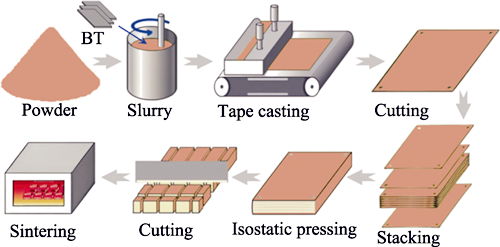
|
|
|
Textured PT-based Piezoelectric Ceramics: Development, Status and Challenge
WU Jie, YANG Shuai, WANG Mingwen, LI Jinglei, LI Chunchun, LI Fei
2025 Vol. 40 (6): 575–586
 Abstract
Abstract(
569 )
 HTML
HTML(
31)
 PDF
PDF(3718KB)(
1400
)
Piezoelectric materials, which serve as converters between mechanical energy and electric energy, are important functional materials. Recently, the technology for textured piezoelectric ceramics has become an important technical approach for developing the next generation of high-performance piezoelectric materials. By tailoring grain orientation, textured piezoelectric ceramics exhibit properties akin to single crystals, exhibiting enhanced piezoelectric and electromechanical properties, as well as improved thermal stability. Furthermore, as polycrystalline ceramics, textured ceramics inherit the advantages of traditional ceramic materials, including ease of fabrication, favorable mechanical properties, and suitability of special-shape and syntype. This paper provides a brief introduction to texturing technique, development of perovskite templates for textured ceramics, and research results related to lead titanate (PbTiO3, PT) based textured piezoelectric ceramics. It systemizes the development and status of the piezoelectric textured ceramics while summarizing their technical advantages. Additionally, the existing scientific problems and future challenges of PT-based textured piezoelectric ceramics are analyzed, focusing on the suitability of templates and matrix via theoretical prediction, the relationship between microstructure and macroscopic properties of textured ceramics, and piezoelectric devices based on textured piezoelectric ceramics. By reviewing the PT-based textured piezoelectric ceramics, this paper aims to provide an in-depth introduction to texturing techniques and theories, seeks to enhance understanding of textured piezoelectric ceramics, and promotes the development of high- performance piezoelectric materials. This work is expected to benefit the breakthrough innovation and leap forward development of next generation high-end piezoelectric devices.
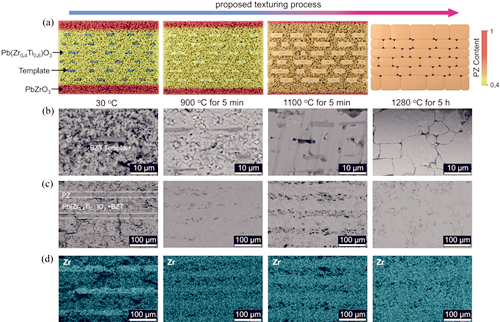
|
|
|
Recent Progress of Hybrid Improper Ferroelectrics with Ruddlesden-Popper Structure
ZHANG Bihui, LIU Xiaoqiang, CHEN Xiangming
2025 Vol. 40 (6): 587–608
 Abstract
Abstract(
361 )
 HTML
HTML(
38)
 PDF
PDF(13228KB)(
1133
)
Hybrid improper ferroelectricity (HIF) is recognized as a secondary ferroelectric phenomenon induced by coupling of in-plane rotation and out-of-plane tilt of anion octahedra in compounds with the units of perovskite structure. HIF is expected to be applicable in the multiferroic materials with strong magnetoelectric coupling owing to its intrinsic characteristic for electric-field control of magnetism, thereby greatly extending the connotation and denotation of ferroelectric physics. This paper focuses on the experimental progress of HIF materials with Ruddlesden-Popper (R-P) structure. It also establishes the linear relationship between Curie temperature (TC) and tolerance factor (τ) of double-layered R-P oxides, elucidating the underlying physical mechanisms of HIF. Based on intrinsic electric-field control of magnetism for HIF, the detection of coexistence of polar and weak ferromagnetic phases in ferrites with double-layered R-P structures is of great scientific significance. Additionally, the documented ferroelectricity in the A-site cation-ordered triple-layered R-P oxide has significantly expanded the fields of HIF. Although significant progress has been achieved in understanding HIF in R-P oxides, more efforts should be made to explore more new material systems and single-phase multiferroic materials.
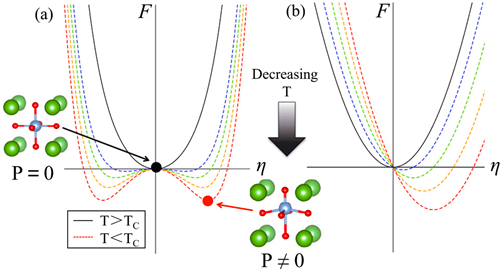
|
|
|
Usage of the P-V-L Bond Theory in Regulating Properties of Microwave Dielectric Ceramics
HU Zhichao, YANG Hongyu, YANG Hongcheng, SUN Chengli, YANG Jun, LI Enzhu
2025 Vol. 40 (6): 609–626
 Abstract
Abstract(
484 )
 HTML
HTML(
37)
 PDF
PDF(6660KB)(
1242
)
The rapid development of communication technology has put forward increasingly stringent requirements on dielectric ceramic filters. Efficient design of novel dielectric materials to facilitate their progression is of great significance. The relationship between structure and performance of materials is crucial for the synthesis and design of microwave dielectric ceramics. The P-V-L bond theory aims to provide crystal structure parameters and basic chemical bond characteristics through calculations, such as the bond ionicity, bond covalency, bond sensitivity, lattice energy, and bond energy. These parameters provide a theoretical basis and guidance for modification design of microwave dielectric ceramics. In recent years, researchers have been committed to applying the P-V-L bond theory to a large number of ceramic systems to explain the relationship between structure and performance of microwave dielectric ceramics. Based on this theory, new modification strategies have been proposed to obtain excellent microwave dielectric properties. This review provides a comprehensive overview of the fundamental concepts of the P-V-L bond theory and the binary bonding formula of complex polycrystals, and outlines the methods of calculating chemical bond parameters and chemical bond characteristics in the field of microwave dielectric ceramics. Meanwhile, the application of the P-V-L bond theory in several common microwave dielectric ceramic systems in recent years is analyzed. Data from literatures show that the P-V-L bond theory analysis can provide the bond characteristics in ion-doped modified systems, as well as the structural evolution and dielectric properties. This understanding is highly significant for guiding development and application direction of microwave dielectric ceramics.
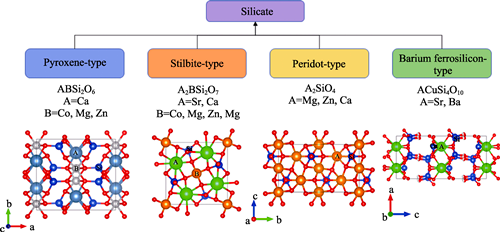
|
|
|
Research Progress on Low-temperature Sintering of PZT Ceramics
JIANG Kun, LI Letian, ZHENG Mupeng, HU Yongming, PAN Qinxue, WU Chaofeng, WANG Ke
2025 Vol. 40 (6): 627–638
 Abstract
Abstract(
527 )
 HTML
HTML(
40)
 PDF
PDF(6771KB)(
1530
)
Pb(Zr,Ti)O3 (PZT) ceramics play a crucial role in fields such as national defense, healthcare, communication, and energy conversion due to their excellent piezoelectric, ferroelectric, and pyroelectric properties. However, the sintering temperature of PZT ceramics usually exceeds 1200 ℃, resulting in high energy consumption and a large amount of PbO volatilization. This volatilization disrupts the stoichiometric balance of PZT ceramics, thereby adversely affecting their electrical properties. Moreover, the rapid development of piezoelectric multilayer devices further requires PZT ceramics to be co-sintered with low-cost metal electrodes at low temperatures. To address these challenges, researchers have extensively investigated the low-temperature sintering of PZT piezoelectric ceramics, successfully reducing the sintering temperature of PZT ceramics to below 1000 ℃, which has attracted widespread attention. Starting from the structural characteristics and physical properties of PZT ceramics, this article reviews the current research status of low-temperature sintering technology in the field of PZT ceramics. It mainly introduces the current status of low-temperature sintering techniques, including spark plasma sintering, hot-pressing sintering, cold sintering, as well as the use of sintering aids such as forming solid solutions, liquid-phase sintering, and transient liquid-phase sintering. The influence of these sintering techniques on the microstructure and electrical properties of PZT piezoelectric ceramics is systematically summarized. The issue of electrical performance degradation caused by sintering aids and possible solutions are analyzed. At last, future development trends of low-temperature sintering technologies for PZT ceramic are explored.

|
|
|
Ba(Nd1/2Nb1/2)O3: Au Underrated K40 Microwave Dielectric Ceramic
HE Guoqiang, ZHANG Kaiheng, WANG Zhentao, BAO Jian, XI Zhaochen, FANG Zhen, WANG Changhao, WANG Wei, WANG Xin, JIANG Jiapei, LI Xiangkun, ZHOU Di
2025 Vol. 40 (6): 639–646
 Abstract
Abstract(
340 )
 HTML
HTML(
36)
 PDF
PDF(5851KB)(
866
)
Microwave dielectric ceramics are indispensable materials in the field of electronic communication, especially in high-frequency applications. They are widely used in microwave components such as resonators, filters, and oscillators due to their unique dielectric properties, including high relative dielectric constant (εr), low dielectric loss, and a temperature coefficient of resonant frequency (τf) close to zero. In this study, a Ba(Nd1/2Nb1/2)O3 (BNN) ceramic with a medium dielectric constant was prepared, which was confirmed to be monoclinic system with the space group C12/m1 through X-ray diffraction (XRD) and Rietveld refinement. As the sintering temperature increasing, the samples' densities initially rose, reaching a maximum bulk density (ρobs) of 6.32 g/cm3 and a relative density (ρrel) of 98% at 1550 ℃ before subsequently decreasing. The sample sintered at 1525 ℃ showed the best microwave dielectric properties: εr=38.44, a quality factor Q×f=25400 GHz, and τf=-6×10-6 ℃-1. It is worth noting that compared to the previously reported value of 11700 GHz, the Q×f value of BNN ceramic in this study increased by 117%, indicating that the microwave dielectric properties of BNN ceramic may have been underestimated due to factors such as testing methods, raw material properties and processing conditions. In addition, a full-dielectric frequency selective surface (FSS) was designed and simulated using this ceramic material, achieving a relative bandwidth of about 23.3%, and demonstrating excellent frequency selection performance. These attributes underscore the potential of BNN ceramics for applications in microwave dielectric ceramic materials and affirm its previously underestimated capabilities, as evidenced by the remarkable performance observed in FSS simulation.

|
|
|
Crystal Structure and Terahertz Dielectric Properties of (Ti0.5W0.5)5+ Doped MgNb2O6 Ceramics
HUANG Zipeng, JIA Wenxiao, LI Lingxia
2025 Vol. 40 (6): 647–655
 Abstract
Abstract(
298 )
 HTML
HTML(
47)
 PDF
PDF(3350KB)(
1057
)
MgNb2O6 ceramics offer advantages such as moderate sintering temperature and low dielectric loss, making them widely applicable in the field of wireless communications. However, the correlation mechanism between MgNb2O6 structure and terahertz dielectric properties remains inadequately understood. To address this gap, MgNb2-x(Ti0.5W0.5)xO6 (x=0-0.03) ceramics were prepared by solid state reaction method in this study. The crystal structure of MgNb2-x(Ti0.5W0.5)xO6 (x=0-0.03) ceramics and its correlation with terahertz dielectric properties were studied using Rietveld refinement, complex chemical bond theory, and terahertz time domain spectroscopy. The global instability index was introduced to characterize the in-lattice strain in single-phase MgNb2O6 system, establishing a correlation among in-lattice strain, lattice energy and terahertz dielectric loss. The results show that (Ti0.5W0.5)5+ ions can modify the crystal structure. With the increase in doping amount, the internal strain reduces, and the stability of crystal structure and lattice energy increases, leading to decrease in dielectric loss. In addition, the atomic packing density increases with higher (Ti0.5W0.5)5+ ion doping, which effectively inhibits the anharmonic vibration of the crystal and further reduces the dielectric loss. At a sintering temperature of 1340 ℃, MgNb2-x(Ti0.5W0.5)xO6 (x=0.03) ceramics have excellent terahertz dielectric properties, with a dielectric constant (εr) of 19.32, a dielectric loss of 0.003 (@0.30 THz), and an absorption coefficient of 1.64 cm-1 (@0.30 THz). The MgNb2-x(Ti0.5W0.5)xO6 (x=0.03) ceramics prepared in this study have a good application prospect in terahertz devices.
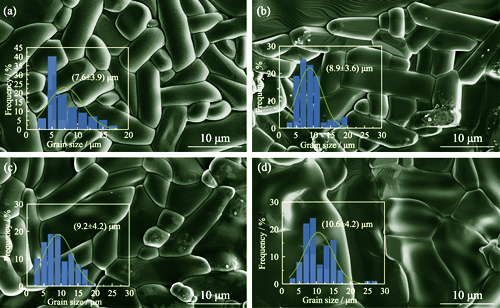
|
|
|
Rattling Effect: A New Mechanism Affecting the Resonant Frequency Temperature Coefficient of Microwave Dielectric Ceramics
TANG Ying, LI Jie, XIANG Huaicheng, FANG Weishuang, LIN Huixing, YANG Junfeng, FANG Liang
2025 Vol. 40 (6): 656–666
 Abstract
Abstract(
529 )
 HTML
HTML(
49)
 PDF
PDF(2756KB)(
916
)
Microwave dielectric ceramics are the key basic materials of 5G/6G communication technology, with particular emphasis on the materials that exhibit a high quality factor (Q×f), low dielectric constant (εr) and near-zero temperature coefficient of resonant frequency (τf). However, most low-εr materials tend to have a significantly negative τf value. This study provides a systematic overview of the classical ionic polarizability dilution mechanism and phase transition mechanism, along with the structural factors affecting τf, such as unit cell volume mechanism, oxygen polyhedron distortion, bond energy, bond ionicity, and bond valence. Subsequently, the anomalous changes in τf in the cubic normal and inverse garnet systems without phase transition are described in detail. The “Rattling” effect is introduced as a novel mechanism affecting the τf of microwave dielectric ceramics. Cations involved in “Rattling”, characterized by high coordination and weak chemical bonds, are the primary factors affecting the overall microwave dielectric polarization and loss of the material. This phenomenon results in an increase in ionic polarizability and εr, a forward shift in τf and a reduction in Q×f value, which has been verified and applied in many different material systems. Furthermore, the introduction of a weighted function for total ion polarization deviation serves to evaluate the impact of the entire molecule's “Rattling” and “Compressed” effects on εr. A novel concept of temperature coefficient of ionic polarizability (ταm) is also proposed, allowing for quantitative calculation. This simplifies the factors that affect the positive and negative of dielectric constant temperature coefficient (τε), by relating it to εr, ταm and linear expansion coefficient αL.
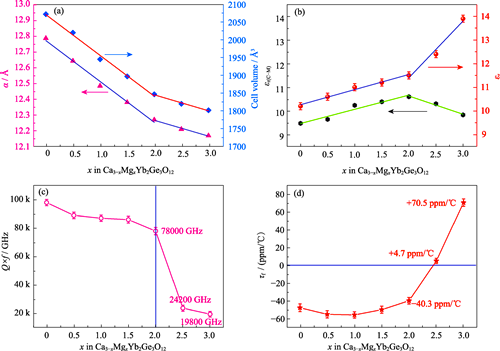
|
|
|
Effects of Growth Conditions on the Formation of Self-assembly Grown Topological Domain in BiFeO3 Nanoislands
ZHOU Houlin, SONG Zhiqing, TIAN Guo, GAO Xingsen
2025 Vol. 40 (6): 667–674
 Abstract
Abstract(
321 )
 HTML
HTML(
40)
 PDF
PDF(21332KB)(
279
)
Ferroelectric topological domain structures exhibit rich physical properties, displaying a wide range of application potential for next-generation nanoelectronic devices. The fundamental issue for the applications of topological devices lies in the precise design and control of ferroelectric topological domain states. Here, the effects of growth conditions on center-type quadrant topological domain configurations in BiFeO3 (BFO) nanoislands formed through bending-induced bulges were investigated, which were generated by underlying electrode SrRuO3 (SRO) nanoislands. The experimental results indicate that the formation of central-type topological domains is closely related to the growing conductions of SRO electrode nanoislands, nanoislands dimensions, temperature of BFO epitaxial growth, and BFO deposition thickness. When the lateral size of the electrode nanoislands ranges from 300 to 400 nm, the subsequently grown BFO thin film with nanoislands, and central-type four-quadrant topological domains can be induced by the underlying electrode protrusions. As the height of the electrode nanoislands gradually increases, the domain structure of the ferroelectric nanoislands changes from stripe domains of the thin film to central-type topological domains. However, at the diameter of electrode nanoisland exceeding 500 nm, the central domain transforms into a zigzag domain-wall configuration, demonstrating the important role of flexoelectric effects induced by morphological protrusions in the formation of topological domains. Within certain growth parameters (growth temperature in the range of 690-730 ℃ and BFO thickness in the range of 30-60 nm), increasing the growth temperature facilitates formation of complete four-quadrant central-type topological domains, revealing synergistic interactions among defects, domain wall energy, and flexoelectric effects on the formation of central domain states. This central-type topological domain can also be switched by external field, and simultaneously induce switching between high/low conductive states, laying a foundation for the further construction of polarization topological electronic devices.
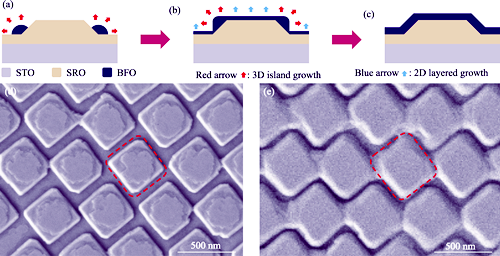
|
|
|
Characterizations by Piezoresponse Force Microscopy on Relaxor Properties of Pb(Mg,Nb)O3-PbTiO3 Ultra-thin Films
DONG Chenyu, ZHENG Weijie, MA Yifan, ZHENG Chunyan, WEN Zheng
2025 Vol. 40 (6): 675–682
 Abstract
Abstract(
308 )
 HTML
HTML(
39)
 PDF
PDF(16019KB)(
236
)
Relaxor ferroelectrics exhibit extensive applications in sensing technology, optoelectronics, high-density memory storage, and neuromorphic computing, owing to their superior dielectric and piezoelectric characteristics. However, conventional methods, including the Sawyer-Tower circuit and the positive-up-negative-down (PUND) pulse train, prove inadequate for nanoscale ultra-thin films, since the relaxor characteristics may be hindered by substantial leakage currents. In this study, a piezoresponse force microscopy (PFM)-based method for characterizing nanoscale relaxor properties was proposed. Taking ultra-thin Pb(Mg,Nb)O3-PbTiO3 (PMN-PT) films as examples, this work compares polarization hysteresis behavior under On-field and Off-field modes of the dual AC resonance tracking (DART) PFM measurements between relaxor PMN-PT and ferroelectric Pb(Zr,Ti)O3 (PZT) thin films with varying thicknesses. Relaxor characteristics of nanometer-thick PMN-PT films are characterized by modulating amplitude of AC readout to eliminate potential false signals. Furthermore, PFM characterizations of PMN-PT ultra-thin films under different in-plane compressive strains and thicknesses demonstrate that the relaxor characteristics are suppressed and ferroelectric properties are observed at relatively large compressive strains of 3.19%. Additionally, the critical thickness for ferroelectric-relaxor transition is identified. These results verify availability of the proposed PFM-based method for characterizing nanoscale relaxor properties. Therefore, this study not only provides a novel characterization method for exploration of the relaxor in ultra-thin films, but also establishes a foundation for understanding the relaxor polarization behavior in ferroelectric materials, thereby advancing applications of relaxor ferroelectric materials in low-dimensional electronic devices.
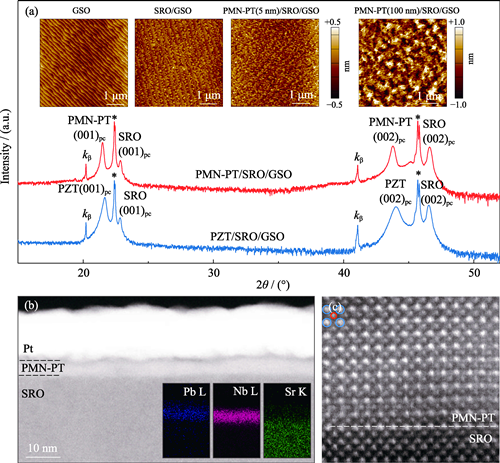
|
|
|
Application of Electron Energy-loss Spectroscopy to BaTiO3 Multi-layer Ceramic Capacitors
WU Lukang, FU Zhengqian, YU Ziyi, YANG Jun, ZHOU Bin, CHEN Xuefeng, XU Fangfang
2025 Vol. 40 (6): 683–689
 Abstract
Abstract(
465 )
 HTML
HTML(
32)
 PDF
PDF(12501KB)(
163
)
BaTiO3 multi-layer ceramic capacitors (MLCCs) are meeting the growing performance demands in consumer electronics, aerospace and defense research. Distribution and segregation of elements during complex fabrication process of MLCCs significantly affect the phase composition, microstructures and hence the performance, which necessitates an effective analytical means capable of accurately resolving elements of MLCCs at microscopic scales. Elemental analysis techniques integrated with modern transmission electron microscope (TEM) have unique advantages due to their ultra-high spatial resolution, reaching the sub-angström scale. Among them, energy dispersive X-ray spectroscopy (EDS) provides a simple and fast way for qualitative analysis of metallic elements. However, their limitations, such as low sensitivity for detecting the light element O, and more critically, low energy resolution (~130 eV), which results in the severe overlap of spectral peaks of Ba and Ti elements, hinder accurate quantitative analysis of BaTiO3. In contrast, electron energy-loss spectroscopy (EELS) possesses ultra-high energy resolution (<1.0 eV), and can provide additional information regarding chemical valence, thus demonstrating enhanced potentials and advantages in the micro-scale elemental analysis of MLCC. In this work, EELS is employed to address the limitation of EDS in distinguishing between Ba and Ti elements due to the overlap of spectral peaks. In addition, EELS reveals that proportion of Ti3+ ions is higher in smaller BaTiO3 grains. Meanwhile, EELS line-scan analysis of individual grains indicates that Ba element diffuses more easily than Ti during sintering process of ceramics. Given its high spatial resolution, EELS offers more accurate and comprehensive information on the elements and valence states, thereby providing potential support for the process improvement and performance optimization of MLCC.
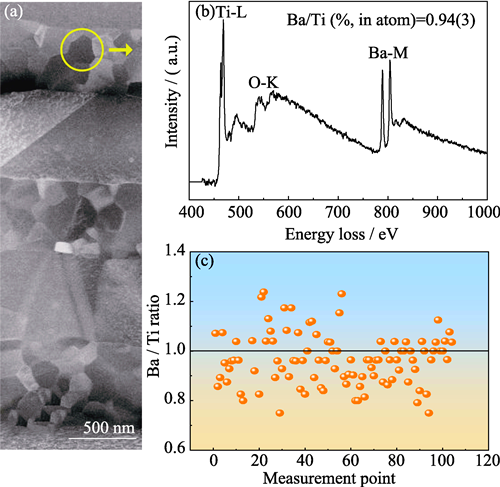
|
|
|
Electrical Properties of Bismuth Layered Piezoelectric Bi4Ti3O12 Ceramics with A/B-site Doping
ZHANG Jiawei, CHEN Ning, CHENG Yuan, WANG Bo, ZHU Jianguo, JIN Cheng
2025 Vol. 40 (6): 690–696
 Abstract
Abstract(
349 )
 HTML
HTML(
14)
 PDF
PDF(7481KB)(
358
)
In recent years, there has been an urgent need for piezoelectric ceramic material capable of operating at temperatures of 450 ℃ and above, which serves as a piezoelectric sensing element in high-temperature piezoelectric vibration sensors. Bi4Ti3O12 (BIT) is a piezoelectric ceramic with a high Curie temperature (TC~650 ℃) within the family of bismuth-layered ferroelectric ceramics, making it a promising candidate for high-temperature applications. However, inherent low piezoelectric constant (d33) and low high-temperature resistivity of pure phase BIT ceramics limit their application in such environments. This work used solid-phase reaction method to prepare BIT-based piezoelectric ceramics with substitutions at A-site by Ce ions and at B-site by W/Ta/Sb ions (BCTWTaS-100x, x=0-0.04). Effect of Ce doping on the structure and electrical properties of BIT-based ceramics was studied. Introduction of Ce ions induces lattice distortion and modifies domain structure of BIT-based ceramics, thereby enhancing their piezoelectric properties (with a d33 of 37 pC/N at x=0.03). With doping concentration of ions increasing, relative displacement of oxygen atoms at apex of TiO6 octahedra increases, resulting in increased lattice distortion within BIT-based ceramic. Furthermore, BCTWTaS-3 ceramics demonstrate a high TC of 673 ℃ and high-temperature resistivity maintaining on the order of 106 Ω·cm at 500 ℃. These ceramics also exhibit good thermal stability of d33. Notably, after depolarization at 600 ℃ for 2 h, d33 can still maintain over 85% of its initial value. These finds indicate that BCTWTaS-100x ceramics have great potential for application in high-temperature environments exceeding 450 ℃.
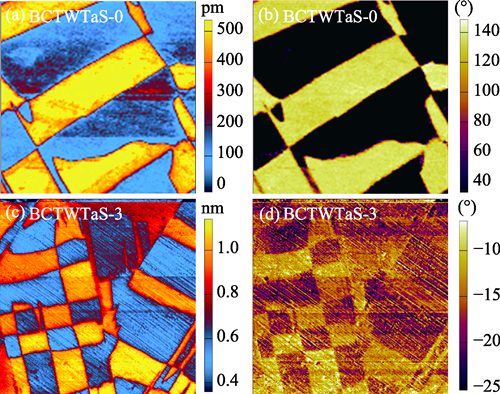
|
|
|
Effect of V5+ Substitution on Microstructure and Microwave Dielectric Properties of LaTaO4 Ceramics
LI Wenyuan, XU Jianan, DENG Han'ao, CHANG Aimin, ZHANG Bo
2025 Vol. 40 (6): 697–703
 Abstract
Abstract(
337 )
 HTML
HTML(
15)
 PDF
PDF(4958KB)(
111
)
Microwave dielectric ceramics are essential materials for 5G/6G communication technology and are primarily employed in fabrication of electronic components such as resonators, filters and dielectric substrates. With the increasing frequency of wireless mobile communication, it is necessary to develop microwave dielectric ceramics with higher quality factor (Q) and near-zero temperature coefficient of resonance frequency (τf), thus effectively compensating for rapid attenuation of high-frequency signals in transmission process and enhancing stability of their operation. Consequently, La(Ta1-xVx)O4 (LTV-x, 0≤x≤0.4) ceramics were prepared by solid-phase sintering. The structure and dielectric properties of ceramics were investigated using crystal structure refinement, transmission electron microscopy and microwave dielectric property measurements. Two specific compositions of La(Ta1-xVx)O4 ceramics with excellent microwave dielectric properties were synthesized in this system, namely LTV-0.3 (relative dielectric constant εr=22.15, Q×f=90100 GHz, τf=-9.52×10-6 ℃-1) and LTV-0.4 (εr=21.75, Q×f=84100 GHz, τf=-4.50×10-6 ℃-1) ceramics. Results indicate that V5+ substitution induces the phase transition of LaTaO4 from monoclinic (P21/c) to orthorhombic (Cmc21) phases, while the phase transition temperature is effectively reduced. Their εr and τf values decrease with increasing x due to phase transition. The Q×f values are influenced not only by relative density but also by packing fraction of the unit cell. Considering their low loss and good temperature stability, these ceramic materials demonstrate promising potential for applications in mobile communication base stations, satellite navigation and radar communication technologies.
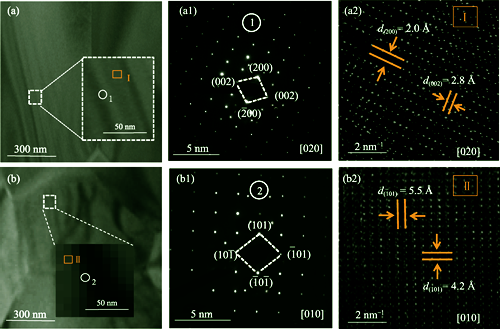
|
|
|
Effect of Ga3+ Doping on Crystal Structure Evolution and Microwave Dielectric Properties of SrAl2Si2O8 Ceramic
YIN Changzhi, CHENG Mingfei, LEI Weicheng, CAI Yiyang, SONG Xiaoqiang, FU Ming, LÜ Wenzhong, LEI Wen
2025 Vol. 40 (6): 704–710
 Abstract
Abstract(
289 )
 HTML
HTML(
20)
 PDF
PDF(2287KB)(
184
)
The feldspar-based microwave dielectric ceramic with low relative permittivity (εr) and excellent mechanical properties has attracted much attention in the fifth-generation wireless communication technology. In this work, a series of microwave dielectric ceramic SrAl2-xGaxSi2O8 (0.1≤x≤2.0) was synthesized using the traditional solid-state method. X-ray diffraction pattern indicates that Ga3+ can be dissolved into Al3+, forming a solid solution. Meanwhile, substitution of Ga3+ for Al3+ can promote the space group transition from I2/c (0.1≤x≤1.4) to P21/a (1.6≤x≤2.0) with coefficient of thermal expansion (CTE) increasing from 2.9×10-6 ℃-1 to 5.2×10-6 ℃-1. During this substitution, the phase transition can significantly improve the structural symmetry to enhance the dielectric properties and mechanical properties. Rietveld refinement results indicate that Ga3+ averagely occupied four Al3+ compositions to form solid solution. All ceramics have a dense microstructure and high relative density above 95%. An ultralow εr of 5.8 was obtained at x=1.6 composition with high quality factor (Q×f) of 50700 GHz and negative temperature coefficients of resonant frequency (τf) of approximately −35×10-6 ℃-1. The densification temperature can be reduced to 940 ℃ by adding 4% (in mass) LiF, resulting in good chemical compatibility with Ag electrode. Meanwhile, negative τf can be tuned to near-zero (+3.7×10-6 ℃-1) by adding CaTiO3 ceramic.

|
|
|
Low Temperature Sintering of ZnAl2O4 Ceramics with CuO-TiO2-Nb2O5 Composite Oxide Sintering Aid
YANG Yan, ZHANG Faqiang, MA Mingsheng, WANG Yongzhe, OUYANG Qi, LIU Zhifu
2025 Vol. 40 (6): 711–718
 Abstract
Abstract(
281 )
 HTML
HTML(
19)
 PDF
PDF(2248KB)(
257
)
ZnAl2O4 and ZnAl2O4-based ceramics have attracted much attention from researchers due to their good microwave dielectric, thermal and mechanical properties. In this work, the influence of 5% (in mass) CuO-TiO2-Nb2O5 (CTN) ternary composite oxide additives with different composition ratios on sintering behavior and properties of ZnAl2O4 microwave dielectric ceramics was investigated. When the molar fraction ranges of Cu, Ti and Nb elements in 5% CTN additives are 0.625-0.875, 0-0.250 and 0.125-0.625, respectively, sintering temperature of ZnAl2O4 ceramics can be reduced from above 1400 ℃ to below 1000 ℃. The sintering additives CN (Cu : Nb=1 : 1, molar ratio) and CTN (Cu : Ti : Nb=4 : 1 : 3, molar ratio) can reduce sintering temperature of ZnAl2O4 ceramics to 975 and 1000 ℃, respectively, while maintaining good dielectric properties (dielectric constant εr=11.36, quality factor Q׃=8245 GHz and εr=9.52, Q׃=22249 GHz) and flexural strengths (200 and 161 MPa), which are expected to be applied in preparation of low temperature co-fired ceramic (LTCC) materials with copper electrodes. Low-temperature sintering of the ZnAl2O4+CTN system is characterized as activated sintering. Nanometer-level amorphous interfacial films containing Cu, Ti, and Nb elements are observed at the grain boundaries, which may provide fast diffusion pathways for mass transportation during the sintering process. Valence changes of Ti and Cu ions, along with changes of oxygen vacancies, are confirmed, which provides a potential mechanism for reduced sintering temperature of ZnAl2O4 ceramics. In addition, a series of reactions occurring at the grain boundaries can activate these boundaries and further promote the sintering densification process. These results suggest a promising way to design a novel LTCC material with excellent properties based on the low temperature sintering of ceramics with the sintering aid of CuO-TiO2-Nb2O5 composite oxide.
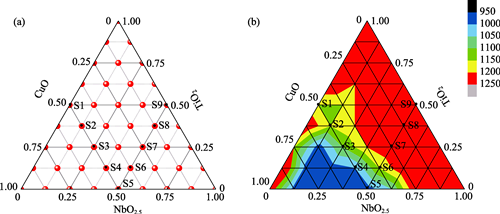
|
|
|
Enhancement of Piezoelectric Properties in CaBi4Ti4O15-based Ceramics through Bi3+ Self-doping Strategy
ZHOU Yangyang, ZHANG Yanyan, YU Ziyi, FU Zhengqian, XU Fangfang, LIANG Ruihong, ZHOU Zhiyong
2025 Vol. 40 (6): 719–728
 Abstract
Abstract(
259 )
 HTML
HTML(
16)
 PDF
PDF(4613KB)(
161
)
High-temperature piezoelectric vibration sensors are the preferred choice for structural health monitoring in harsh environments such as high temperatures and complex vibrations. Bismuth layer-structured CaBi4Ti4O15 (CBT) high-temperature piezoelectric ceramics, with high Curie temperature (TC), are the key components for piezoelectric vibration sensors operating at temperatures exceeding 500 ℃. However, their low piezoelectric coefficient (d33) greatly limits their high-temperature applications. In this work, a novel Bi3+ self-doping strategy was employed to enhance the piezoelectric performance of CBT ceramics. The enhancement is attributed to an increase in the number of grain boundaries, providing more sites for space charge accumulation and promoting formation of space charge polarization. Furthermore, given that space charge polarization predominantly occurs at low frequencies, dielectric temperature spectra at different frequencies were used to elucidate the mechanism by which space charge polarization enhances piezoelectric properties of CBT ceramics. Excellent overall performance was achieved for the CBT-based high-temperature piezoelectric ceramics. Among them, TC reached 778 ℃, d33 increased by more than 30%, reaching 20.1 pC/N, and the electrical resistivity improved by one order of magnitude (reaching 6.33×106 Ω·cm at 500 ℃). These advancements provide a key functional material with excellent performance for practical applications of piezoelectric vibration sensors at 500 ℃ and above.
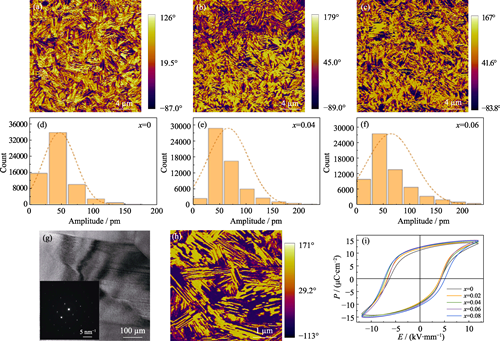
|
|
|
Enhanced Piezoelectric Properties of (1-x)(0.8PZT-0.2PZN)-xBZT Ceramics via Phase Boundary and Domain Engineering
CHEN Xiangjie, LI Ling, LEI Tianfu, WANG Jiajia, WANG Yaojin
2025 Vol. 40 (6): 729–734
 Abstract
Abstract(
521 )
 HTML
HTML(
19)
 PDF
PDF(4646KB)(
111
)
Pb(Zr,Ti)O3-Pb(Zn1/3Nb2/3)O3 (PZT-PZN) based ceramics, as important piezoelectric materials, have a wide range of applications in fields such as sensors and actuators, thus the optimization of their piezoelectric properties has been a hot research topic. This study investigated the effects of phase boundary engineering and domain engineering on (1-x)[0.8Pb(Zr0.5Ti0.5)O3-0.2Pb(Zn1/3Nb2/3)O3]-xBi(Zn0.5Ti0.5)O3 ((1-x)(0.8PZT-0.2PZN)- xBZT) ceramic to obtain excellent piezoelectric properties. The crystal phase structure and microstructure of ceramic samples were characterized. The results showed that all samples had a pure perovskite structure, and the addition of BZT gradually increased the grain size. The addition of BZT caused a phase transition in ceramic samples from the morphotropic phase boundary (MPB) towards the tetragonal phase region, which is crucial for optimizing piezoelectric properties. By adjusting content of BZT and precisely controlling position of the phase boundary, the piezoelectric performance can be optimized. Domain structure is one of the key factors affecting piezoelectric performance. By using domain engineering techniques to optimize grain size and domain size, piezoelectric properties of ceramic samples have been significantly improved. Specifically, excellent piezoelectric properties (piezoelectric constant d33=320 pC/N, electromechanical coupling factor kp=0.44) were obtained simultaneously for x=0.08. Based on experimental results and theoretical analysis, influence mechanisms of phase boundary engineering and domain engineering on piezoelectric properties were explored. The study shows that addition of BZT not only promotes grain growth, but also optimizes the domain structure, enabling the polarization reversal process easier, thereby improving piezoelectric properties. These research results not only provide new ideas for the design of high-performance piezoelectric ceramics, but also lay a theoretical foundation for development of related electronic devices.
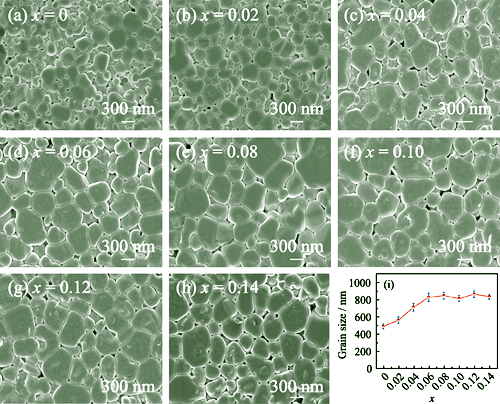
|
|